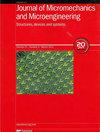飞秒激光烧蚀 4H-SiC 衬底的实验研究
IF 2.1
4区 工程技术
Q2 ENGINEERING, ELECTRICAL & ELECTRONIC
引用次数: 0
摘要
数据访问声明:支持本出版物的研究数据可从位于 www.NNN.org/download/ 的 NN 储存库获取。碳化硅(SiC)是制造大功率电子器件和微波器件的理想衬底,具有广阔的应用前景。碳化硅晶片的表面处理在半导体工业中起着至关重要的作用,同时也面临着挑战。在多种处理方法中,基于激光的方法逐渐引起了学者们的关注。因此,本研究采用飞秒激光对 4H-SiC 切片进行烧蚀,并分析了激光脉冲能量、散焦量、重复频率和扫描间隔等关键参数对激光烧蚀深度、宽度和表面形貌的影响。扫描电子显微镜(SEM)和激光相干聚焦显微镜用于表征激光烧蚀表面。结果表明,在散焦量为 +6 mm、激光脉冲能量为 87.5 μJ、扫描速度为 500 mm/s、脉冲频率为 300 kHz 的条件下。结果表明,优化后的表面粗糙度(Sa)为 0.267μm,原始表面上的微裂纹和凹坑等脆性断裂区域已被去除。有效的去除促进了材料表面的进一步加工,为类似研究人员提供了宝贵的见解,也为半导体行业带来了益处。伦理合规性:在涉及人类参与者的研究中执行的所有程序均符合机构和/或国家研究委员会的伦理标准,以及 1964 年《赫尔辛基宣言》及其后期修订版或类似的伦理标准。本文章由计算机程序翻译,如有差异,请以英文原文为准。
Experimental study on femtosecond laser ablation of 4H-SiC substrate
Data Access Statement: Research data supporting this publication are available from the NN repository at located at www.NNN.org/download/. Silicon carbide (SiC) is an ideal substrate for manufacturing high-power electronic devices and microwave devices, and has broad application prospects. The surface treatment of SiC wafers plays a critical role and faces challenges in the semiconductor industry. Among the multiple treatment methods, the laser-based method has gradually attracted the attention of scholars. Therefore, this research uses a femtosecond laser to ablate 4H-SiC sliced wafers and analyzes the influence of key parameters, such as laser pulse energy, defocus amount, repetition frequency, and scanning intervals, on the laser ablation depth, width, and surface morphology. Scanning electron microscopy (SEM) and laser coherence-focused microscopy were used to characterize the laser ablation surface. The results show that under a defocus amount of +6 mm, a laser pulse energy of 87.5 μJ, scanning speed of 500 mm/s, and pulse frequency of 300 kHz. The results show that the optimized surface roughness (Sa) was 0.267μm, and brittle fracture areas such as microcracks and pits on the original surface were removed. Effective removal facilitates further material surface processing, which provides valuable insights for similar researchers and benefits for the semiconductor industry. Ethical Compliance: All procedures performed in studies involving human participants were in accordance with the ethical standards of the institutional and/or national research committee and with the 1964 Helsinki Declaration and its later amendments or comparable ethical standards.
求助全文
通过发布文献求助,成功后即可免费获取论文全文。
去求助
来源期刊

Journal of Micromechanics and Microengineering
工程技术-材料科学:综合
CiteScore
4.50
自引率
4.30%
发文量
136
审稿时长
2.8 months
期刊介绍:
Journal of Micromechanics and Microengineering (JMM) primarily covers experimental work, however relevant modelling papers are considered where supported by experimental data.
The journal is focussed on all aspects of:
-nano- and micro- mechanical systems
-nano- and micro- electomechanical systems
-nano- and micro- electrical and mechatronic systems
-nano- and micro- engineering
-nano- and micro- scale science
Please note that we do not publish materials papers with no obvious application or link to nano- or micro-engineering.
Below are some examples of the topics that are included within the scope of the journal:
-MEMS and NEMS:
Including sensors, optical MEMS/NEMS, RF MEMS/NEMS, etc.
-Fabrication techniques and manufacturing:
Including micromachining, etching, lithography, deposition, patterning, self-assembly, 3d printing, inkjet printing.
-Packaging and Integration technologies.
-Materials, testing, and reliability.
-Micro- and nano-fluidics:
Including optofluidics, acoustofluidics, droplets, microreactors, organ-on-a-chip.
-Lab-on-a-chip and micro- and nano-total analysis systems.
-Biomedical systems and devices:
Including bio MEMS, biosensors, assays, organ-on-a-chip, drug delivery, cells, biointerfaces.
-Energy and power:
Including power MEMS/NEMS, energy harvesters, actuators, microbatteries.
-Electronics:
Including flexible electronics, wearable electronics, interface electronics.
-Optical systems.
-Robotics.
 求助内容:
求助内容: 应助结果提醒方式:
应助结果提醒方式:


